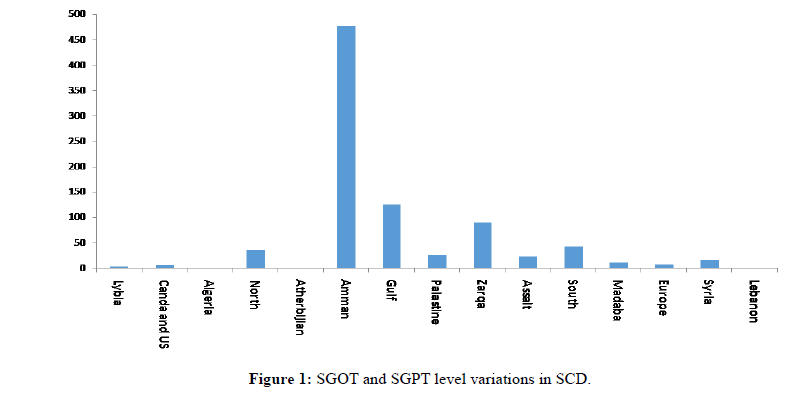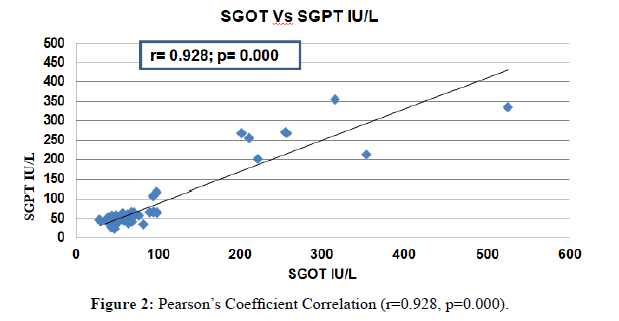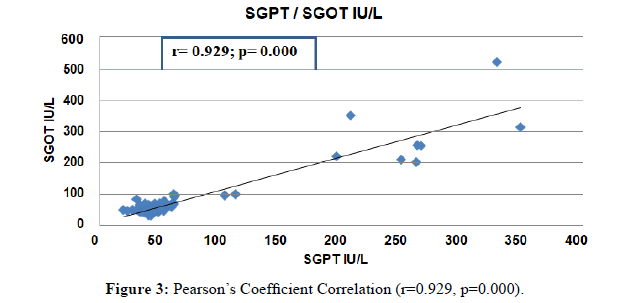HTML
Original Research Article - (2022) Volume 12, Issue 4
SGOT and SGPT Variations with their Pearson's Coefficient Correlation in Sickle Cell Disease
Chandrakant G Kamble1, Prashant J Hisalkar2, Ivvala Anand Shaker3* and Jagdish Powar4*Correspondence: Ivvala Anand Shaker, Department of Biochemistry, Parul Institute of Medical Sciences & Research, Vadodara, Gujarat, India, Email:
2Department of Biochemistry, Government Medical College and Hospital, Dungarpur, Rajasthan, India
3Department of Biochemistry, Parul Institute of Medical Sciences & Research, Vadodara, Gujarat, India
4Department of PSM, SMBT Institute of Medical Sciences and Research Centre, Dhamangaon, Maharashtra, India
Received: 01-Apr-2022, Manuscript No. IJP-22-54885; Editor assigned: 05-Apr-2022, Pre QC No. IJP-22-54885 (PQ); Reviewed: 20-Apr-2022, QC No. IJP-22-54885; Revised: 28-Apr-2022, Manuscript No. IJP-22-54885 (R); Published: 05-May-2022, DOI: 10.37532/2249-1848.2022.12(4).16
Abstract
Background: Sickle cell disease is an inherited disorder caused by the single point mutation due to the replacement of valine for glutamic acid at the sixth codon of β-chain of globins (β6Glu → Val). The sickle cell disease condition with hepatic dysfunction shows the abnormal variations in liver function tests including serum aminotransferases enzymes like SGOT and SGPT level were changed and to discuss their significance in sickle cell disease.
Materials and methods: This study was being conducted in the Department of Biochemistry, People’s College of Medical Sciences and Research Centre (PCMS and RC), and Centre for Scientific Research and Development Department (CSRD), People’s University, Bhopal. The study protocol and ethical clearance had been approved by Institutional Ethical Committee (Reference number: PCMS/OD/2016/2551). The sample size was estimated by the expert statistician, which were 111 for case sample and controls. These were employed in the research study after the application of the inclusion and exclusion criteria.
The liver function enzymes SGOT and SGPT were estimated by Reitman and Frankel’s method and were diagnosed by using the Trans Asia diagnostic kits manufactured by TRANSASIA BIO- MEDICALS LTD., B-11, and OIDC. RINGANWADA, DAMAN-396210 (India) in collaboration with ERBA diagnostics Mannheim HmbH Mallaustr. 69-73, D-68291, Mannheim/Germany
Results: In the present study, the mean standard deviations of cases vs. controls were showed significant difference and it was calculated by using the SPSS latest software version-24.
The Mean ± SD cases vs. controls of SGOT and SGPT were found in 69.98 ± 69.31; 25.17 ± 5.25 and 65.28 ± 60.07; 22.72 ± 5.47 respectively. The calculated p?0.000 was found to be statistically highly significant. The Pearson’s Correlation showed positive correlation in between SGOT and SGPT enzymes.
Conclusion: The transaminases SGOT-SGPT enzymes were significantly increased in sickle cell disease so it could be another clinical bio-marker for the diagnosis of sickle cell disease.
Keywords
SGOT, SGPT, Pearson’s correlation, Sickle cell disease.
Introduction
Sickle cell disease is an inherited disorder caused by the single point mutation due to the replacement of glutamic acid to valine at the sixth codon of β-chain of globins (β6Glu → Val) which is an alternation of single nucleotide base from thymine to adenine (GTG → GAG) the molecular change is responsible for the alternation in the properties of the haemoglobin tetramer, with a tendency to polymerize in the deoxygenated state altering normal, flexible, biconcave shaped Red Blood Cells (RBCs) in to stiff, rigid, sickle cell RBCs [1,2]. These changes is related to fundamental pathophysiology, vaso-occlusion, tissue ischemia, sickle shaped erythrocytes, leucocytes, platelets and endothelial cells [2].
Hepatic dysfunction is usually known problem of sickle cell disease due to multiple factors such as intrahepatic sinusoidal sickling and transfusion related hepatic infections [3].
The sickle cell disease conditions with hepatic dysfunction shows the abnormal variations in liver function tests including serum aminotransferases, bilirubin and alkaline phosphatase [4]. Our study focuses on the clinical investigation of serum aminotransferase enzymes.
Materials and Methods
Place and ethical clearance of the study
This study was being conducted in the Department of Biochemistry, People’s College of Medical Sciences and Research Centre (PCMS&RC) and Centre for Scientific Research and Development department (CSRD), People’s University, Bhopal. The study protocol and ethical clearance had been approved by the Research Advisory Committee (Ref. number: PCMS/OD/2016/2566) and Institutional Ethical Committee (Ref. No: PCMS/OD/2016/2551).
Sample size estimation
The sample size estimation had been carried out and confirmed by the expert statistician. The estimation was based on the prevalence of sickle cell disease in Madhya Pradesh, it was found in between the range of 15% to 30% [5-7].
The sample size estimation was carried out by using the formula: N=4PQ/L²
The estimated sample size was found to be 110.68. Hence 111 SCD sample cases or more samples are necessary to meet the desired statistical constraints and 111 healthy subjects were enrolled with their consent forms for the controls group in the study.
Study design
Type of study: This is a hospital based, case control, prospective study.
Study duration: The study sample collection had been started from the year 2019 and finished in December-2020.
Source of SCD subjects: The blood samples for the study were collected from People’s Hospital and Civil Hospital Bairagarh, Bhopal, Madhya Pradesh.
Study criteria
Inclusion criteria for Sickle cell disease subjects:
A. The subject has a diagnosis of sickle cell disease with other sickle cell related complications alongside acute sickle pain, including not limited to acute chest syndrome, renal dysfunction, liver dysfunction stroke, vaso-occlusive event, and priapism have been included in the study. Patients more than 5 years of age and less than 70 years of age are included in the present study.
B. All the selected and enrolled patients had been confirmed with their specific characters with a single blood transfusion of 3-4 months before blood drawn. The patients with hospitalization were included in the study and were might be or might not be under the continuous antibiotics therapy, Hydroxyurea (HU) treatment. The patients under hydroxyurea treatment advised to stop hydroxyurea for 15-20 days, and after that the blood has to be collected for the research study.
Exclusion criteria for sickle cell disease subjects:
A. Sickle cell subjects less than 5 years and more than 70 years are excluded from the study.
B. Individuals with other hemoglobinopathy are also been excluded from the study.
C. SCD patients under chemotherapy treatment were excluded from the study.
D. For the safety precautions in handling the blood samples, patients with HIV, Hepatitis B, and Hepatitis C will be excluded from the study. HIV, Hepatitis B, and Hepatitis C testing will not be done under this study.
Source of normal healthy subjects
The control group consist 111 healthy normal individuals, healthy persons were comprised of departmental staff, medical students and relatives who were healthy and accompany their OPD or IPD, and their health condition was being detected.
Inclusion criteria
A. Healthy subjects more than 5 years age and less than 70 years of age.
B. Normal healthy individuals were recruited as control group.
Exclusion criteria for control subjects
A. Participants do not have a diagnosis of sickle cell disease or not any type of hemoglobinopathy.
B. Healthy subjects less than 5 years age and more than 70 years of age were excluded.
Informed consent
The informed consent forms were obtained from the SCD patients and also from the healthy control group. All procedures followed were being in accordance and approved by the Institutional Ethics Committee of the People’s College of Medical Sciences & Research Center, Bhopal and also with the Helsinki Declaration of 1975 and its revisions.
Blood sample collection
The 5 ml overnight fasting venous blood had been collected from patients and controls under aseptic conditions. Then 5 ml blood was taken in to a plain vacutainer. Then the sample was centrifuged at 3000 rpm for 10 minutes for separation of the serum sample and then the separated sample was immediately stored in a deep freezer at -20°C until its used for further analysis.
Conformation tests for SCD
The following screening tests had been carried out with SCD patients for the confirmation of sickle cell RBCs
1. Sickling test with 2% meta-bisulfite: It is the principle of the sickling test, was based on microscopically observation of sickling of red blood cells when exposed to low oxygen tension.
2. Solubility test with 0.02% sodium dithionate: It is the principle of solubility method, based on turbidity created when Hb S is mixed with sodium dithionate.
3. Peripheral blood film method: Thin blood films, stained with giemsa stain were examined by light microscopy (× 100).
4. Hb electrophoresis: The cellulose acetate membrane Hb electrophoresis method had been used to determine the presence of Hb-S in the sample.
The liver function enzymes SGOT and SGPT were estimated by Reitman and Frankel’s method and were diagnosed by using the Trans Asia diagnostic kits. Manufactured by Transasia Bio-Medicals LTD., B-11, OIDC. Ringanwada, DAMAN-396210 (India) in collaboration with ERBA diagnostics Mannheim HmbH Mallaustr. 69- 73, D-68291, Mannheim/Germany.
Statistical analysis
The statistical calculation was calculated by using the SPSS latest software version-24. We observed that, SGOT and SGPT were found statistically highly significant in Sickle cell disease cases as compared to the controls. Pearson’s Coefficient Correlation shows us positive Correlation with each other. The p˂0.000 was considered to be statistically highly significant.
Results and Discussion
The activity of SGOT and SGPT has widely used liver function tests to assess the liver conditions; both the enzymes are very sensitive and reliable for the assessment of liver function tests. These enzymes was increased in SCD due to the organ damage property of sickling mechanism that causes liver dysfunction [7].
In our findings also, the liver enzymes SGOT and SGPT were found increased significantly high in SCD cases but in the controls were found within the normal levels (Table 1). There was the highly significant difference observed in between patients and controls of the above SGOT and SGPT variables. Since the p˂0.000 (p˂0.0001=highly significant and p˂0.005 significant).
| Variables | Group | N | Mean | SD | ‘t’ value | ‘p’ value | Significance level |
|---|---|---|---|---|---|---|---|
| SGOT IU/lit. | Patients | 111 | 69.98 | 69.31 | 6.79 | <0.000 | Highly significant |
| Control | 111 | 25.17 | 5.25 | ||||
| SGPT IU/lit. | Patients | 111 | 65.28 | 60.07 | 7.43 | < 0.000 | Highly significant |
| Control | 111 | 25.17 | 5.25 |
An increase in SGOT and SGPT is due to the rapid sickling of RBCs in sickle cell disease; the transamination was not completed so the enzymes were not utilized for the conversion of keto acids that leads to increases the transaminases SGOT and SGPT [8].
Our outcomes are correlated with Richard, et al [8]. he stated that the statistically significant alterations in the levels of liver enzymes and other parameters were also seen in all the patients of SCD as compared to controls (p<0.0001), were the levels of LFT parameters significantly (p<0.0001) elevated in cases as compared to controls. But in steady state of sickle cell disease, Richard, et al. studied the same variables in which he reported that, there were no significant alterations in the levels of liver function enzymes in steady state, that could be due to the steady state of the patients where sickling and hemolysis is occur [8]. Mahera, et al. Gardner, et al. concluded in their studies that, there was a significant increase in LFT parameters which were similar to both the results. The similarities were observed in their studies and Gardner K, et al. also studied a milder increase of LFT were also observed in the SCD cases (Figure 1) [9,10].
The graph designating that there was severely increased level of SGOT and SGPT found in the sickle cell disease patients as compared to the control. We have also studied by using Pearson’s Correlation Coefficient which showed very significant positive correlation which supported by the different articles discussed in Figure 2. Akuyam, et al. studied in 2007 and he found that there were statistically highly significant increased levels of Total bilirubin, Sr. AST, Sr. ALT and ALP in sickle cell disease [7]. Gardner, et al. and Brody, et al. stated through the observations of his study that, the previous elevations of the Sr. AST (94.4%), ALT (2.8%), were found more in SCD patients [10,11]. Norris, et al. reported that, the acute sickling process selectively affects the liver in 10% of the patients, causing a liver crisis with abdominal pain, nausea, fever, jaundice and transaminases (SGOT and SGPT) were found elevated in SCD [12].
Similarly the scientists Johnson, Schubert, Sheehy and Stephan were stated that, the liver enzymes transaminases were significantly increased in sickle cell hepatopathy, which was due to the rapid sickling and hemolysis of the red blood cells. Schubert, et al. and above other two scientist studied that the enzyme ALP was also markedly elevated in the sickle cell disease, but the ratio of serum aspartate amino transferease and serum alanine amino transferease enzymes were not altered significantly [4, 13-15].
The Figure 3 below showed that there were significant positive Pearson’s correlation coefficient between SGPT and SGOT where r=0.929; p=0.000 [4, 13-15].
Conclusion
The transaminases SGOT-SGPT enzymes were significantly increased in sickle cell disease. So, these two will be other important variables for the diagnosis of sickle cell disease. They also explained that, Sr. AST enzyme was mostly found elevated excessively due to an increased rate of hemolysis of RBCs in sickle cell disease and significantly increase in level of serum bilirubin was also seen due to the ongoing and increased rate of hemolysis in intrahepatic cholestasis and renal impairments encountered in sickle cell hepatopathy in comparison with the other remaining all diseases. Thus, the study could be concluded that, an increase in SGOT, SGPT, might be due to the rapid sickling of RBCs in sickle cell disease.
References
- Rees GP, Williams TN, Gladwin M. Lancet. 2010;376:2018-2031.
[CrossRef] [Google Scholar] (All versions) [PubMed]
- Ballas SK. Drugs. 2002;62:1143-1172.
[CrossRef] [Google Scholar] (All versions) [PubMed]
- Kakarala S, Lindberg M. Conn Med. 2004;68:277-279.
- Schubert TT. Gastroenterology. 1986;90:2013-2021.
[CrossRef] [Google Scholar] [PubMed]
- Gupta VK, Singh N, Masram SW, et al. J Med Sci Clin Res. 2015;3:6886-6891.
- Tiez NW. Clin Chem. 1986.
- Akuyam AS, Bamidele AS, Aminu SM, et al. Borno Med J. 2007;4:1-6.
[Google Scholar] (All versions)
- Richard S, Billett HH. Clin Lab Haematol. 2002;24:21-27.
[CrossRef] [Google Scholar] [PubMed]
- Mahera MM, Mansour AH. Gastroenterol Res. 2009;2:338-343.
[CrossRef] [Google Scholar] [PubMed]
- Gardner K, Suddle A, Kane P, et al. Blood. 2014;123:2302-2307.
[CrossRef] [Google Scholar] [PubMed]
- Brody JI, Ryan WN, Haidar MA. JAMA. 1975;232:738-741.
[Google Scholar] [PubMed]
- Norris WE. J Natl Med Assoc. 2004;96:1235-1239.
[Google Scholar] [PubMed]
- Johnson CS, Omata M, Tong MJ, et al. Medicine. 1985;64:349-356.
[CrossRef] [Google Scholar] (All versions) [PubMed]
- Sheehy TW. South Med J. 1977;70:533-538.
[Google Scholar] [PubMed]
- Stephan IJ, Merpit-Gonon E, Richard O, et al. Eur J Pediatr. 1995;154:469-471.
[CrossRef] [Google Scholar] [PubMed]
Manuscript Submission
Submit your manuscript at Online Submission System
Google scholar citation report
Citations : 1101
International Journal of Pharmacy received 1101 citations as per google scholar report
International Journal of Pharmacy peer review process verified at publons
Indexed In
- CAS Source Index (CASSI)
- HINARI
- Index Copernicus
- Google Scholar
- The Global Impact Factor (GIF)
- Polish Scholarly Bibliography (PBN)
- Cosmos IF
- Open Academic Journals Index (OAJI)
- Directory of Research Journal Indexing (DRJI)
- EBSCO A-Z
- OCLC- WorldCat
- MIAR
- International committee of medical journals editors (ICMJE)
- Scientific Indexing Services (SIS)
- Scientific Journal Impact Factor (SJIF)
- Euro Pub
- Eurasian Scientific Journal Index
- Root indexing
- International Institute of Organized Research
- InfoBase Index
- International Innovative Journal Impact Factor
- J-Gate




